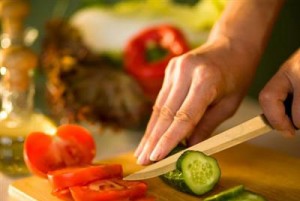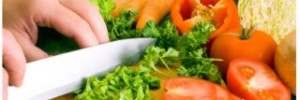General guide on vegetables preparation
Vegetables can be prepared by dry-heat (baking, roasting, sauteing, or deep-fat frying) or moist-heat (simmering, steaming, or microwaving) methods, and can be served plain, buttered, creamed, au gratin, glazed, scalloped, stuffed, or in souffles, omelets, and cream soups.
Regardless of the cooking method or serving style selected, some general principles governing the handling and preparation of vegetables should be followed:
- Buying – Purchase only the freshest possible vegetables in amounts that will be used within a few days.
- Storage – Store vegetables immediately at the appropriate temperature and do not leave them out of storage for any length of time unless they are being prepared. Leftovers should be refrigerated immediately and used within a day or two.
- Washing. – All vegetables must be thoroughly washed (with a vegetable brush when appropriate) to remove soil. microorganisms, pesticides, and herbicides. Washing should be quick, because most vegetables absorb excess water when soaked. Many root vegetables, except beets and baked potatoes, are also peeled.
- Cooking liquid – As small an amount of liquid as possible should be used; in many cases, leftover liquids may be saved for stock.
- Timing – The cooking time should be as short as possible; most vegetables when heated too long will undergo undesirable changes in quality. Vegetables should be served promptly after cooking.
 Vegetable Changes During Heating
Vegetable Changes During Heating
When heated, vegetables undergo several changes in texture, flavor, odor, color, and nutrient retention. Understanding these phenomena can help to retain as much of their quality as possible during preparation.
Texture. High temperatures gelatinize starch, decrease bulk by softening cellulose, and cause a reduction in turgor due to water loss. Although this is desirable when baking potatoes or cooking legumes, it is not recommended for most other vegetables; they should be heated until barely cooked. Acids or acidic foods, such as vinegar or tomatoes, should be added toward the end of the cooking time, because they make vegetables more resistant to softening and, by precipitating vegetable pectins, increase required heating time.
To compensate for turgor lost during processing, calcium salts are often added to pickles and canned vegetables to make them firmer. The salts combine with pectic substances and become insoluble, finning the food’s texture. Other calcium sources include molasses, hard water, arid brown sugar. Sometimes the toughness of green beans and other vegetables is actually due to preparing them in hard water. Adding alkaline ingredients such as baking soda has the opposite effect of breaking down cellulose and producing a very mushy texture.
Flavor. Vegetables obtain their flavors from an assortment of volatile oils, organic acids, sulfur compounds, mineral salts, carbohydrates, and polyphenolic compounds. In general, to retain these flavor compounds, vegetables should be heated in as little water as possible and for as short a time as will do the job. There are exceptions; long gentle heat yields milder flavors in onions. Garlic flavor also depends on whether it is raw or cooked. Raw garlic is very pungent, yet becomes mellow or sweet when cooked slowly, and even nutty and rich when cooked at length. Only low to medium-low heats should be used for cooking garlic, because it cooks quickly and will become bitter when burned. Most of the substances that cause bitterness in vegetables such as cucumber and eggplant can be eliminated with peeling. Those that lurk under the skin can be drawn out prior to cooking by the technique of degorging. Droplets containing the bitter compounds are drawn out by osmotic pressure and can then be soaked up with a paper towel or rinsed off and patted dry.
Odor. Food odors contribute to the perception of flavor, but some odors, such as that from cooked cabbage or onions, may be undesirable. These pungent odors are generated by sulfur compounds present in the Cruciferae family (the cruciferous vegetables) and the Allium genus (onions, garlic, shallots, leeks, chives).
Garlic, onions, shallots, and leeks are odorless until they are cut or bruised, which allows an enzyme to contact a particular substrate to create a distinctive-smelling sulfur compound. The strong odors of cooked cabbage and onion can be reduced by shortening the heating time, adding a little vinegar to the cooking water, and/or by removing the lid occasionally during cooking to let volatile organic acids escape.
Color. Both fat- and water-soluble pigments are affected by pH, heating, and the presence of metals. Undesirable color changes can be prevented in a number of ways. Red cabbage, rich in anthocyanins, is prevented from turning blue if cooked with something acidic such as apples or a teaspoon of vinegar or lemon juice. Anthoxanthincontaining foods such as potatoes, rice, cauliflower, and onions are normally cream-white in color, but turn yellowish if exposed to hard water. This can be prevented by adding 1/2 teaspoon of cream of tartar, vinegar, or lemon juice to each gallon of water used. Adding baking soda to green vegetables makes them appear greener; however, this is not recommended due to the deleterious effect on B vitamins and texture.
Influences other than pigments on color include the Maillard reaction, the caramelization of sugars, and enzymatic browning. Enzymatic browning may be observed in cut-up potatoes that turn pinkish-brown when exposed to oxygen. Some potatoes turn dark blue-gray when oxygen reacts with the natural iron content of the potato. This discoloration can be prevented by soaking cut potatoes in water sprinkled with a little lemon or orange juice, or with cream of tartar added (1 teaspoon per quart) to increase acidity.
Nutrient Retention. Careful preparation of vegetables conserves important nutrients. Since leaching is the greatest cause of mineral loss in vegetables, it is important to cook them using as little water as possible. In many instances, it is better to avoid immersing them in water altogether and instead revert to steaming, baking, or microwaving. Other ways to minimize nutrient loss are to leave the skin on whenever possible, to cut vegetables into fewer, larger pieces rather than many smaller pieces, and to cook just to the point of doneness and no further.
Some nutrients may actually increase during food preparation, desirably or not. Frying vegetables increases the fat content of the finished product. Heating also increases the amount of protein available from legumes by destroying the enzymes known as protease inhibitors. Heat softens a food’s fiber content and may even increase it as a percentage of weight after some natural water loss due to heating.
